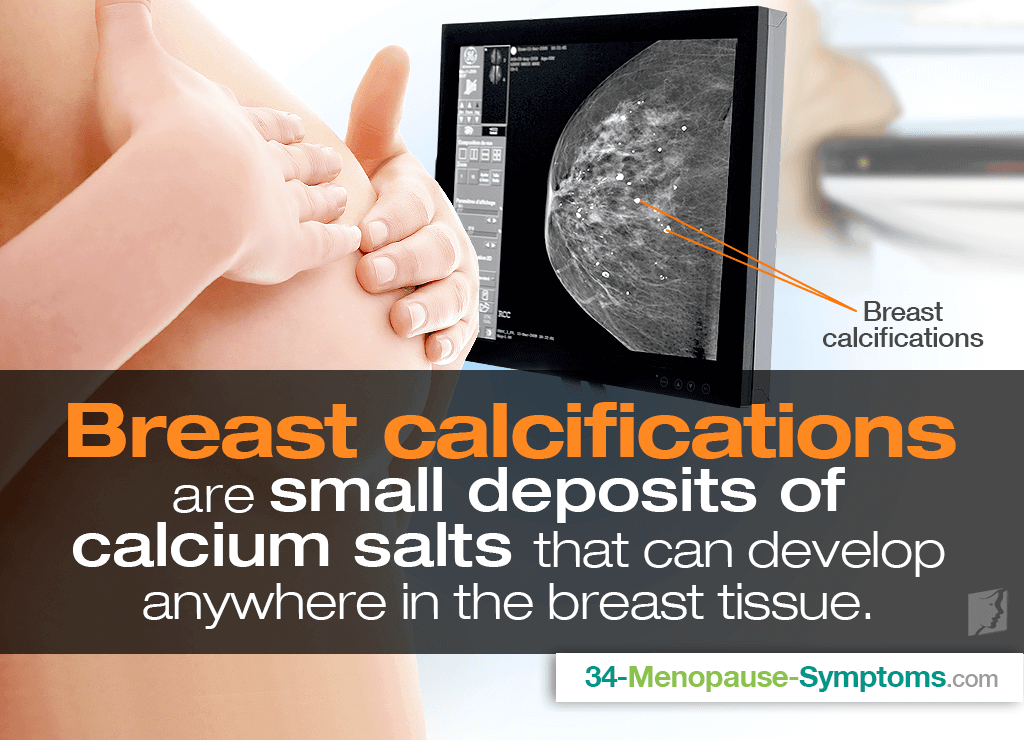A diagnosis of breast calcifications may leave women wondering exactly what the condition entails and whether they will be able to cure themselves of them.
Continue reading to learn important information about breast calcifications, including what they are, their causes, symptoms, treatment, and more.
What are Breast Calcifications?
Breast calcifications are small deposits of calcium salts that can develop anywhere in the breast tissue.
Although they are usually benign, meaning noncancerous, these deposits can develop in certain patterns, like close-knit clusters with irregular shapes, which could signify breast cancer or precancerous breast tissue changes.
What Causes Breast Calcifications?
Although breast calcifications can develop naturally as women age, they are extremely prevalent among menopausal women, leading some experts to believe they may be caused by hormonal changes taking place in women's bodies during this transformative time.
Hormonal causes
Research has shown that there is a statistically significant relationship between menopause and the presence of breast calcifications, with there being a greater presence of calcifications in those who are perimenopausal (those undergoing the menopausal transition) versus premenopausal (those in their best reproductive years).
Further studies have shown that women in postmenopause, or the years following menopause, with greater body sizes - and thus, higher blood estrogen levels - have a lower probability of having breast calcifications than those who are smaller with lower estrogen levels.
This leads us to believe that estrogen has a positive effect on breast tissue health, and its deficiency - once ovaries stop reproductive functions - can cause breast abnormalities.
Other causes
Small deposits of calcium in the breast tissue can also be caused by breast cysts; fibroadenoma, a solid, benign mass most common in younger women; mammary duct ectasia; previous breast injury or surgery, including radiation therapy; skin or blood vessel calcifications; cell secretions; and many more.
What are Symptoms of Breast Calcifications?
These small calcium deposits do not cause symptoms nor breast pain. They are too small to be felt during routine breast exams and are usually first identified on a mammogram as white spots or flecks.
How Can I Treat Breast Calcifications?
If you have been diagnosed with breast calcifications, follow-up and treatment will be according to the condition's specific cause. If the deposits are believed to be due to cancer, another mammogram or a biopsy will be pursued for further testing. If caused by a benign condition, your radiologist will encourage a six-month follow-up to monitor changes.
In the meantime, menopausal women whose breast calcifications are due to low estrogen levels have various treatment options available to them, starting with lifestyle adjustments and alternative medicines shown to promote hormonal balance.
Lifestyle changes include instilling an optimized diet rich in phytoestrogens, plant-based estrogens that can act as the endogenous hormone in the body to appropriately balance levels and regular exercise into your schedule to promote optimal endocrine system health. For improved results, consider the use of phytoestrogenic herbal supplements - which are more concentrated in phytoestrogens than foods - or hormone-balancing supplements, which nourish the endocrine and pituitary glands to encourage natural hormone production.
Many measures used as breast pain treatments may also apply for breast calcifications.
Key Takeaways
Breast calcifications are small deposits of calcium salts. Even though they are usually noncancerous, their patterned presence could signify breast cancer or precancerous breast tissue changes. They are more common in menopausal women, leading researchers to believe that estrogen has a great influence on their development. Although, they can also be caused by a myriad of other conditions, such as fibroadenoma, mammary duct ectasia, breast cysts, and more.
The calcifications, themselves, do not cause any symptoms and are usually first identified on a mammogram. Treatment will depend upon the underlying cause, and a follow-up mammogram or biopsy may be necessary to observe any alterations.
Sources
- Bielak, L.F. et al. (2010). Breast Arterial Calcification Is Associated with Reproductive Factors in Asymptomatic Postmenopausal Women. Journal of Women's Health, 19(9), 1721-1726. doi: 10.1089/jwh.2010.1932
- Breast Cancer Care. (2018). Breast calcifications. Retrieved November 27, 2018, from https://www.breastcancercare.org.uk/information-support/have-i-got-breast-cancer/benign-breast-conditions/breast-calcifications
- Mayo Clinic. (2018). Breast calcifications: Definition | Causes | When to see a doctor. Retrieved November 27, 2018, from https://www.mayoclinic.org/symptoms/breast-calcifications/basics/definition/sym-20050834 | https://www.mayoclinic.org/symptoms/breast-calcifications/basics/causes/sym-20050834 | https://www.mayoclinic.org/symptoms/breast-calcifications/basics/when-to-see-doctor/sym-20050834
- Naseem, M. et al. (2015). Mammographic microcalcifications and breast cancer tumorigenesis: a radiologic-pathologic analysis. BMC Cancer, 15, 307. doi: 10.1186/s12885-015-1312-z




